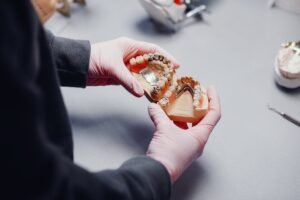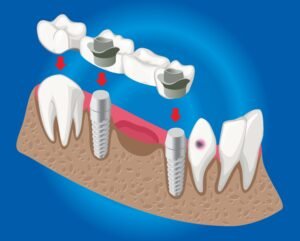Mini dental implants sound like the perfect solution — small, simple, and cheaper than dental implants. But are they really as good as they seem?
Let’s be honest: every treatment has trade-offs. The disadvantages of mini dental implants often show up after the initial benefits fade. While they’re less invasive and faster to place, there are real downsides patients should know before committing.
In this guide, we’ll explore the disadvantages of mini dental implants, look at their pros and cons, and break down how long they last — all in clear, friendly language.
If you’re still weighing your options, you can also explore the different types of dental implants to better understand which might be right for you.
Table of Contents
ToggleWhat Are Mini Dental Implants?
Mini implants are just what they sound like — smaller versions of traditional dental implants. They’re usually less than 3 mm in diameter and used to stabilize dentures or replace small teeth.
People often choose them because:
They’re less invasive (no bone grafting in most cases).
The procedure is faster and recovery is shorter.
The cost is lower than traditional implants.
Sounds great, right? But here’s the catch — their small size limits strength and long-term success. And that’s where the disadvantages of mini dental implants begin to appear.
Key Disadvantages of Mini Dental Implants
3.1 Reduced Strength and Fracture Risk
One of the biggest disadvantages of mini dental implants is their limited strength. Because they’re narrow, they can’t handle as much chewing force. Think of it like using a thin nail to hold a heavy picture — it works for a while, but pressure causes bending or breakage.
Patients with strong bites, bruxism (teeth grinding), or missing back teeth are at higher risk of implant fractures or loosening.
3.2 Limited Bone Contact and Stability
Another major disadvantage of mini dental implants is that they offer less surface area for bone integration. Regular implants have a wider base, allowing more bone-to-implant contact and better stability.
Mini implants, with their reduced surface, are more sensitive to movement during healing. These micromotions can lead to early failure — a key reason why the disadvantages of mini dental implants can outweigh their short-term convenience.
3.3 Higher Failure Rate
Studies show traditional implants succeed 95–98% of the time. In contrast, mini dental implants have higher failure rates, typically 82–94%, depending on bone quality and location.
These disadvantages of mini dental implants become especially apparent in:
The upper jaw (where bone is softer)
Heavy-chewing areas (molars)
Immediate-load cases (same-day teeth)
Wondering, “Are mini dental implants good for everyone?” The answer is: not always. Their design makes them more likely to fail under pressure.
3.4 Limited Use and Anatomical Constraints
The disadvantages of mini dental implants include their restricted use. They’re best suited for:
Lower-jaw dentures
Narrow bone ridges
Temporary solutions
They’re not recommended for molars or patients with poor bone density. So, if you’re missing back teeth or need long-lasting strength, traditional implants or All-on-4 systems are safer options.
3.5 One-Piece Design Problems
Another disadvantage of mini dental implants is their one-piece structure. Most minis combine the implant and abutment. While this simplifies placement, it complicates repair — if the top breaks, the entire implant must be removed.
Regular (two-piece) implants allow for easier adjustments, reducing long-term complications — a significant point when comparing the disadvantages of mini dental implants vs. traditional systems.
3.6 Hygiene and Maintenance Issues
Because they’re smaller, mini implants are harder to clean. This increases the risk of gum inflammation, peri-implantitis, and prosthetic wear. One of the most common mini dental implant problems is hygiene-related failure.
The disadvantages of mini dental implants extend beyond surgery — they demand excellent long-term maintenance. Without it, early failure is more likely.
3.7 Long-Term Cost Concerns
It’s easy to get swayed by the low price tag. But another hidden disadvantage of mini dental implants is the cost of repairs or replacements.
If they fail, you might pay for removal, bone grafting, and reimplantation — often making them more expensive in the long run than standard implants.
Mini vs Regular Implants: A Quick Comparison
| Factor | Mini Dental Implants | Regular Dental Implants |
|---|---|---|
| Diameter | 2–3 mm | 3.5–5 mm |
| Cost | Lower upfront | Higher initial |
| Strength | Weaker | Very strong |
| Lifespan | 5–10 years | 15–25 years |
| Failure Rate | 6–18 % | 2–5 % |
| Ideal Use | Lower dentures, small gaps | Full-arch or molar teeth |
This comparison highlights some core disadvantages of mini dental implants — especially if your goal is long-term reliability.
How Long Do Mini Dental Implants Last?
With proper hygiene and the right case selection, mini implants typically last 7–10 years. But for patients with strong bites or poor bone, they may fail much sooner — yet another disadvantage of mini dental implants to keep in mind.
Curious about the timeline of getting a full implant done? Learn more about how long a dental implant takes.

Are Mini Dental Implants Worth It?
That depends on your needs. For stabilizing dentures quickly, they’re useful. But if you need long-term durability, the disadvantages of mini dental implants may outweigh the benefits.
Always weigh your priorities — and ask your dentist about all options, including implant-supported bridges. You may want to compare mini implants vs bridging of teeth to understand the durability differences.
What is the failure rate of mini dental implants?
Some sources state that mini dental implants may have a failure rate of about 10-30% in some situations. akronbestdentist.com Others give a more conservative estimate of 10-20% over 5 years depending on case selection, technique, and oral condition. casasadobesdentistry.com However, many reports of mini implants (especially for overdentures) show higher success / survival rates: for example, a 12-year study of ~6000 mini implants reported ~93% success for overdentures and ~97% for single-tooth uses. Mini Dental Implant Centers of America In orthodontic mini-implants (temporary anchorage devices, which are related but somewhat different), failures (loss of stability) have been observed in the early weeks—e.g. ~13.6% at 4 weeks in one study.
Are mini implants worth it?
Advantages / reasons people choose them:
Less invasive surgery: smaller diameter means less bone removal, potentially less trauma.
Lower cost in some situations (fewer materials, simpler procedures).
Useful when bone volume is limited, or in narrow ridges where standard implants may not fit.
Good option for stabilizing dentures (overdentures) in some patients.
How painful are mini implants?
The surgical placement of mini implants is typically done under local anesthesia, so patients should not feel pain during the procedure (just pressure or vibration).
After surgery, there is expected postoperative discomfort: swelling, mild-to-moderate pain, soreness in gum and bone, which usually reduces over days.
The pain is generally comparable to conventional implant surgery or other dental surgeries, though because mini implants are less invasive, some patients may experience slightly milder postoperative pain.
Any persistent severe pain, swelling, or signs of infection should be evaluated by the dentist.
What is the life expectancy of mini dental implants?
Many sources quote 5 to 10 years as a typical expected lifespan (for the implant post) under good conditions.
phillydentalspa.com
Some claim that, with excellent care and favorable conditions, they may last decades or even a lifetime.
Dr. Charles Hawkins
The prosthetic (crown or overdenture attachment) parts often wear out earlier (7–10 years or less) and may need replacement.
Long-term data are more limited than for standard implants, and success depends strongly on loading, bone quality, hygiene, and absence of complications.
What are the dark sides of dental implants (including mini)?
Failure / Loss of Osseointegration
The implant may not integrate with the bone, become loose, or fail over time.
Mechanical failure / fracture
Mini implants (especially < 3 mm) carry a risk of bending or fracture under load.
Dimensions of Dental Hygiene
Infection / Peri-implantitis
Inflammation of tissues around the implant, bone loss, or infection can jeopardize stability.
M Sarraf, E Rezvani Ghomi, S Alipour… – Bio-design and …, 2021 – Springer. A state-of-the-art review of the fabrication and characteristics of titanium and its alloys for biomedical applications. springer.com
Cited by 302
A Kurup, P Dhatrak, N Khasnis – Materials Today: Proceedings, 2021 – Elsevier. Surface modification techniques of titanium and titanium alloys for biomedical dental applications: A review. mitwpu.edu.in
Cited by 164
A Bandyopadhyay, I Mitra, SB Goodman… – Progress in materials …, 2023 – Elsevier. Improving biocompatibility for next generation of metallic implants. sciencedirect.com
Cited by 221
A Farrahnoor, H Zuhailawati – International Journal of Materials …, 2021 – degruyter.com. Review on the mechanical properties and biocompatibility of titanium implant: The role of niobium alloying element. researchgate.net
Cited by 13
JV Calazans Neto, CAS Celles… – ACS Biomaterials …, 2024 – ACS Publications. Recent advances and prospects in β-type titanium alloys for dental implants applications. acs.org
Cited by 6



